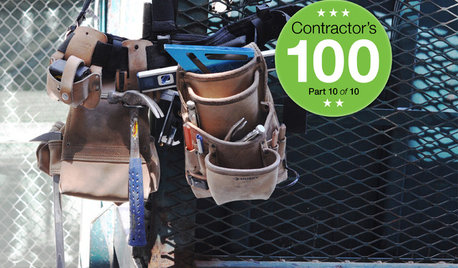Soil issues? Testing for lead??
UrbanGardner100
9 years ago
Related Stories

HEALTHY HOMEGet the Lead Out: Lead Safety at Home
Keep your family safe by properly testing for and dealing with lead in old painted surfaces, water and soil
Full Story
FARM YOUR YARDHow to Get Good Soil for Your Edible Garden
The nutrients in your soil feed the plants that feed you. Here are tips on getting it right — just in time for planting season
Full Story
GARDENING GUIDESGet the Dirt on Your Garden’s Soil
Understand how your soil supports your plants so you can ensure your garden’s success
Full Story
GARDENING GUIDESHow to Stop Worrying and Start Loving Clay Soil
Clay has many more benefits than you might imagine
Full Story
GARDENING GUIDESGardening Solutions for Heavy Clay Soils
What’s a gardener to do with soil that’s easily compacted and has poor drainage? Find out here
Full Story
LANDSCAPE DESIGNHow to Shape a Rain Garden and Create the Right Soil for It
Learn how to grade, lay out and amend the soil in your rain garden to support your plants
Full Story
Kit Houses Stand the Test of Time
See how these mass-produced catalog houses have made their way into the modern day
Full Story
GARDENING GUIDESGarden Myths to Debunk as You Dig This Fall and Rest Over Winter
Termites hate wood mulch, don’t amend soil for trees, avoid gravel in planters — and more nuggets of garden wisdom
Full Story
PETSSo You Want to Get a Cat
If you're a cat lover, the joys outweigh any other issue. If you haven't lived with one yet, here are a few things to know
Full Story
REMODELING GUIDESContractor's Tips: 10 Things Your Contractor Might Not Tell You
Climbing through your closets and fielding design issues galore, your contractor might stay mum. Here's what you're missing
Full Story






toxcrusadr
UrbanGardner100Original Author
Related Professionals
Owings Mills Landscape Architects & Landscape Designers · Salem Landscape Architects & Landscape Designers · Brandon Landscape Contractors · Lake Saint Louis Landscape Contractors · New Cassel Landscape Contractors · Placerville Landscape Contractors · Ramsey Landscape Contractors · Waipahu Landscape Contractors · Wallingford Landscape Contractors · Wanaque Landscape Contractors · Silver Firs Landscape Contractors · Boston Decks, Patios & Outdoor Enclosures · Oswego Decks, Patios & Outdoor Enclosures · Rantoul Decks, Patios & Outdoor Enclosures · Westford Decks, Patios & Outdoor Enclosurestoxcrusadr
Kimmsr
nil13
Kimmsr